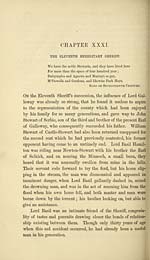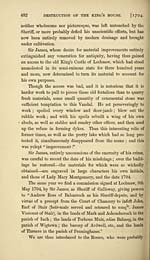Agnews of Lochnaw
(515) Page 481
Download files
Complete book:
Individual page:
Thumbnail gallery: Grid view | List view

I702. ] THE ELEVENTH HEREDITARY SHERIFF. 481
The year before his father's death, the Sheriff's second
daughter, Margaret, married Colonel Agnew of Lochryan, then
major and brevet lieutenant-colonel in the Scots Greys ; and
the Earl of Galloway, and Alexander Maxwell younger of Mon-
reith, were both married to daughters of Lord Eglinton, and
nieces of Lady Mary, the Sheriff's wife.
Sir William Maxwell was a great ally of the Sheriff's, assist-
ing him in various disputes relative to superiorities purchased
from Lord Cassilis in 1701, concerning which there are some
very bulky documents ; as also touching various marches between
himself and Lord Stair, in which case also we find that " the
Sheriff of Galloway and the said Lord Viscount of mutual con-
sent remitted to Sir William Maxwell to take the depositions"
and act as umpire.
The Sheriff energetically followed out the course of agricul-
tural improvement, which his father, in association with Lord
Stair, Lord Basil Hamilton, and Sir Charles Hay, had commenced.
The new school of cattle-breeding proprietors, which had
been inaugurated at Baldoon, set great store by hay, and in the
then state of the country, bog-hay was an article of no inconsider-
able value. Hence, Sir James's eyes being directed to the sheet
of water flowing below his terraces, ornament or sport seemed as
trifles to a field of hay ; and the thought having once occurred,
all his efforts were turned to the accomplishment of his wishes.
By dint of great exertions, a deep cut was made in the direction
of the old mill-race behind Drummullin Hill, by judiciously
deepening which the lake at last yielded to his energy.
There were then three lakes in the neighbourhood. The one
in question — the White Loch — formed by nature to be the chief
ornament of Lochnaw, for more than a century after Sir James'
operations, remained an eyesore as a boggy meadow, until, in
1812, the late Sir Andrew Agnew restored it to its watery
honours. There was next, the Black Loch, a picturesque wild
tarn, with gorse and heath tangled along its rocky edges, which
are partially clothed with brushy wood ; and this still remains.
A third — the Grey Loch — almost inaccessible from swamps, and
2 I
The year before his father's death, the Sheriff's second
daughter, Margaret, married Colonel Agnew of Lochryan, then
major and brevet lieutenant-colonel in the Scots Greys ; and
the Earl of Galloway, and Alexander Maxwell younger of Mon-
reith, were both married to daughters of Lord Eglinton, and
nieces of Lady Mary, the Sheriff's wife.
Sir William Maxwell was a great ally of the Sheriff's, assist-
ing him in various disputes relative to superiorities purchased
from Lord Cassilis in 1701, concerning which there are some
very bulky documents ; as also touching various marches between
himself and Lord Stair, in which case also we find that " the
Sheriff of Galloway and the said Lord Viscount of mutual con-
sent remitted to Sir William Maxwell to take the depositions"
and act as umpire.
The Sheriff energetically followed out the course of agricul-
tural improvement, which his father, in association with Lord
Stair, Lord Basil Hamilton, and Sir Charles Hay, had commenced.
The new school of cattle-breeding proprietors, which had
been inaugurated at Baldoon, set great store by hay, and in the
then state of the country, bog-hay was an article of no inconsider-
able value. Hence, Sir James's eyes being directed to the sheet
of water flowing below his terraces, ornament or sport seemed as
trifles to a field of hay ; and the thought having once occurred,
all his efforts were turned to the accomplishment of his wishes.
By dint of great exertions, a deep cut was made in the direction
of the old mill-race behind Drummullin Hill, by judiciously
deepening which the lake at last yielded to his energy.
There were then three lakes in the neighbourhood. The one
in question — the White Loch — formed by nature to be the chief
ornament of Lochnaw, for more than a century after Sir James'
operations, remained an eyesore as a boggy meadow, until, in
1812, the late Sir Andrew Agnew restored it to its watery
honours. There was next, the Black Loch, a picturesque wild
tarn, with gorse and heath tangled along its rocky edges, which
are partially clothed with brushy wood ; and this still remains.
A third — the Grey Loch — almost inaccessible from swamps, and
2 I
Set display mode to:
![]() Universal Viewer |
Universal Viewer | ![]() Mirador |
Large image | Transcription
Mirador |
Large image | Transcription
Images and transcriptions on this page, including medium image downloads, may be used under the Creative Commons Attribution 4.0 International Licence unless otherwise stated. ![]()
| Histories of Scottish families > Agnews of Lochnaw > (515) Page 481 |
|---|
| Permanent URL | https://digital.nls.uk/94904294 |
|---|
| Description | A selection of almost 400 printed items relating to the history of Scottish families, mostly dating from the 19th and early 20th centuries. Includes memoirs, genealogies and clan histories, with a few produced by emigrant families. The earliest family history goes back to AD 916. |
|---|

